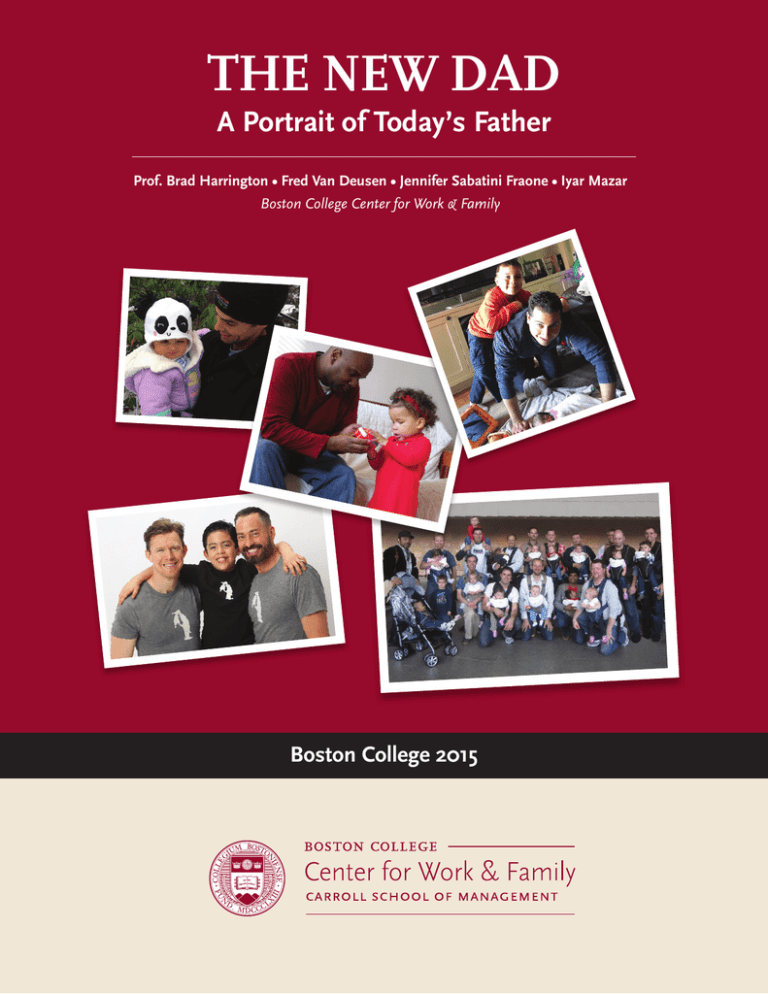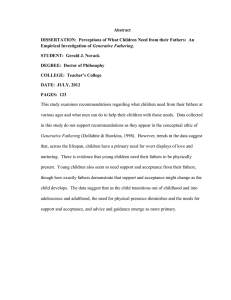THE NEW DAD A Portrait of Today’s Father Boston College 2015
advertisement

THE NEW DAD A Portrait of Today’s Father Prof. Brad Harrington • Fred Van Deusen • Jennifer Sabatini Fraone • Iyar Mazar Boston College Center for Work & Family Boston College 2015 Acknowledgements The publication of this report, the sixth in The New Dad research series, causes us to pause for a moment to think of all of the colleagues, scholars, and fathers who have contributed to our current knowledge about contemporary dads. We also recognize the many organizations, including those in our BC Workforce Roundtable, that are “stepping up” their supports for fathers in the workplace. We are grateful to the media for being willing to engage in this discussion on a larger front, as the potential impacts on society are tremendous. Finally, we thank our own families for the inspiration and encouragement to continue this important work. Copyright 2015 Boston College Center for Work & Family THE NEW DAD: A PORTRAIT OF TODAY’S FATHER Introduction Over the last six years, the Boston College Center for Work & Family (BCCWF) has completed a series of research studies on the changing face of fatherhood in America. In 2009, we recognized that the lack of highquality, in-depth research on fathers had led to many misconceptions, including: tribute our research and to bring to light other interesting information about the ways in which men are re-defining their parenting roles, and the impact this change is having at home and at work. We have been gratified that The New Dad series has contributed to a growing body of knowledge about the experiences and expectations of today’s fathers and has catalyzed a significant increase in the national dialogue on this important subject. This year, our goal is to summarize the state of the research that is being done on fathers to draw a more complete and accurate portrait of today’s new dad. In this report, we will draw from our own work and the research of other leading scholars, in order to provide a deeper understanding of men, careers, and their work & family successes and challenges in the 21st Century. • Inaccurate portrayals of fathers in the media • Outdated workplace assumptions about the caregiving roles that fathers play • Employer work-family programs targeted, explicitly or implicitly, at women, making men reluctant to take advantage of these offerings • Increased work-family conflict for fathers that is not widely recognized or understood Perhaps the most troubling problem is that fathers’ voices have often been absent from, or perhaps even seen as irrelevant to, work-family conversations. In an effort to address this, we began our journey with a relatively smallsample, qualitative study of fathers of very young children to better understand their experiences. We coined the title “The New Dad” for what became our research series and have published a report each year exploring differing perspective of the role dads play today at work and in the home. We also launched thenewdad.org website to dis- Our own research has focused mainly on U.S. fathers who work in large corporations, and what we offer here is best seen as a portrait of those men – primarily “white collar dads” who are college educated, work as professionals and managers, and are mostly living in dualparent households. This report is organized around ten common questions we hear about these fathers and we hope it provides a clearer picture of today’s new dads. 3 1. Breadwinner, Caregiver Or Both? Historically, when it came to job 1, Dad’s role was a given. He was the guy who “brought home the bacon.” He provided his family with the much needed economic means to make all other family objectives possible – from the basic necessities of food and shelter, to the longer term, more strategic investments in funding children’s college educations and mom and dad’s retirement. only $23,000 a year. More than half of the children in these homes live in poverty. Glossing over this fact ignores the importance of having fathers in the picture. The female breadwinners who were living with and earning more than their husbands are in an entirely different income bracket; their median household income is $80,000. And for the remaining 60% of U.S. families where the woman is not the primary breadwinner, clearly fathers are extremely important financial providers. But times have changed. In May, 2013, an attentiongrabbing N.Y. Times headline, “What are fathers for?” highlighted the findings of a Pew Research Center study that found that women were the primary breadwinners in 40% of U.S. households. Does this finding undermine the assumption that providing financially is a father’s primary role? And how do fathers see themselves with regard to their historical role as breadwinner? But that does not mean that fathers today see their role solely or primarily as breadwinners. In our 2011 study: The New Dad: Caring, Committed and Conflicted, fathers were asked to identify where they fell on the continuum between providing for their families’ financial needs and their families’ emotional and physical needs. The result was that more than 2/3 believed the two were equally weighted – they did not see themselves primarily as financial providers as one might expect. In fact, less than 5% of the fathers reported that they saw their role as being a financial provider alone. Perhaps the most important detail behind the headline was glossed over, that in 5 out of 8 of the households where the mother was the primary breadwinner, she was also the only adult present. In homes where an unmarried woman is the sole breadwinner, the family’s average income is How Fathers See Their Responsibilities to Their Children Earning money to meet my child's financial needs. Mostly earning money to meet my child's financial needs, but also providing some physical/emotional care for him/her. Both caring for my child and earning money to meet his/her financial needs. Mostly caring for my child, but also earning some money to meet his/her financial needs. Physically/emotionally caring for my child. 0 10 20 30 40 Percentage 50 60 70 80 Source: The New Dad: Caring, Committed and Conflicted, 2011 According to a May, 2015 article in The Shriver Report, The 21st century American man prioritizes personal success with family, and being present to be a good father, husband, son or friend, over financial independence, professional success, or leaving a legacy. Three in five of today’s men named personal achievement at home as the marker of success, with financial success and independence coming in a distant second at only 24%. Younger American men, those 18-49, are more likely to prize being present, while older American men, those over age 50, cite the importance of being a provider. 4 THE NEW DAD: A PORTRAIT OF TODAY’S FATHER 2. Today’s Dad: More Involved With His Kids? There are two generational effects that seem to have a bearing on today’s fathers. First, young people today are less likely to have reached the traditional milestones of “adulthood” by age 30 than previous generations. A 2014 study by the Pew Research Center found that they are getting married later and having children later. Second, these so-called “Millennials” are less likely to think about their work and family roles as being defined by traditional gender norms. Most believe that they will have partners in life who also have careers and who see their roles as both parent and professional as a shared responsibility (Gerson, 2010). In our 2011 study, 94% of the 1,000 respondents agreed/strongly agreed “If I were considering taking a new job, I would consider how much that job would interfere with my ability to care for my children,” with fathers under 40 even more committed to this than those 40 and above. But the question remains, have these and other factors led today’s dads to be more involved with their children than those of prior generations? Recent research from Jones and Mosher (2013) evaluated how often men engaged in certain parenting activities and compared involvement by age. A greater percentage of younger fathers (age 25-34) reported playing with and bathing, dressing, or diapering their children each day than older fathers (age 35-44). However, the older fathers were more likely to read to their children and feed them each day. Children under 5 years old Father age Playing with children Bathing, dressing, or diapering Reading Feeding or sharing a meal 25-34 years 82.0% 59.1% 27.2% 71.6% 35-44 years 79.0% 54.7% 33.5% 73.0% Source: Jones and Mosher, 2013 Fathers living with children aged five to 18 were asked about the following activities: talking; eating; helping with homework; and dropping off/picking up children from activities. The younger fathers were more engaged than older fathers in all of these activities. Children 5-18 years old Father age Talking to children about their day Helping with homework Dropping off/picking up children from activities Sharing a meal 25-34 years 67.7% 35.3% 22.8% 69.2% 35-44 years 64.3% 27.0% 19.3% 63.7% Source: Jones and Mosher, 2013 Lastly, while nearly half (47.5%) of younger fathers living with a child under 18 reported feeling that they are doing a “very good job” as a parent, a lower percentage (41.6%) of older fathers reported the same. Being a hands-on parent and assisting with the activities of daily living seem to be more of a “given” for young fathers. 5 3. Who Does More, Mom Or Dad? A 2011 Time Magazine cover story titled “Chore Wars” highlighted the struggle that parents face in working fulltime, raising children, and maintaining a household. The historic division of labor in which men go off to work and women take care of children and home is no longer the most common model of the American family, and there is increasing pressure on men to do a greater share of child care and housework. Scholars suggest that this reflects the need for greater paternal involvement at home stemming primarily from mothers’ increased labor force participation. According to a 2015 EY global study, Millennials (78%) are almost twice as likely to have a spouse/ partner working full-time than Boomers (47%). The Bureau of Labor Statistics reports that in 2013 both parents were employed in 59.1% of all married couple families with a child under 18 years old. ers still spend approximately two times as many hours on childcare and housework as fathers do. It is also interesting to examine whether men’s participation in caregiving is different for men whose wives are in the paid labor force versus those whose wives are not. Wang and Bianchi (2009) found that: • Fathers with and without employed spouses reported spending similar amounts of time providing primary childcare per day (roughly one hour). • Fathers whose spouses worked for pay spent significantly more time in solo care activities (i.e. without their spouse present) than men whose wives were at-home full time. • Fathers with spouses in the paid workforce were more involved in childcare, particularly when their children were infants and toddlers, than fathers whose wives did not work. Time use data indicate that men have nearly tripled their time spent providing primary childcare (the amount of time when childcare is their primary activity) over the last few decades (Wang and Bianchi, 2009). Although women continue to spend more hours providing childcare than men do, fathers spent about 2.5 hours in primary childcare activities per week from 1965 to 1985, and that number had grown to nearly 7 hours a week by 2000. A 2015 study done by Yavorsy, Dush and Schoppe-Sullivan, using time diary data from 182 couples who participated in the New Parents Project, found that 95% of both men and women who were about to have their first child agreed that mothers and fathers should equally share the child care responsibility. However, after the arrival of their child, men did about 10 hours a week of physical child care – the “less fun work” such as changing diapers and bathing the baby - while women spent 15 hours per week engaged in those activities. Men spent about 4 hours and women about 6 hours per week in the more “fun” part of parenting, which included activities such as reading to the baby and playing. Moms and Dads, 1965-2011 Average number of hours per week spent on: 1965 Tasks 2011 Mothers Fathers Mothers Fathers Paid Work 8 42 21 37 House Work 32 4 18 10 Child Care 10 2.5 14 5 A Families and Work Institute study of same-sex and different-sex couples indicated that men in same-sex couples have significantly higher satisfaction with the division of household and childcare responsibilities. As these tasks are not able to be divided solely on the basis of traditional gender roles, more conversations occur about how the responsibilities are fulfilled. In both same-sex and different-sex couples, those who have conversations about household responsibilities have a higher satisfaction with the division of labor (Families and Work Institute, 2015). Source: Pew Research Center, 2013 In 2013, the Pew Research Center identified a similar increase in the number of hours that fathers spend with their children. They reported that when you combine child care, housework and paid work time, fathers dedicate approximately the same number of total hours as mothers do in contributing to their family’s well-being, but moth- 6 THE NEW DAD: A PORTRAIT OF TODAY’S FATHER 4. Engaged Dads: Who Benefits? In the 2011 BCCWF research study, we found that most fathers believed they should share their children’s caregiving equally with their spouses; however, only about 30% claimed to be actually doing that. In spite of this reported shortfall, there is ample evidence that fathers not only want to be involved with their children but that they truly are involved with them. Today, fathers are primary caregivers for approximately 21% of children under the age of 5, and 7% of children aged 5-14. These percentages vary dramatically depending on the working status of the fathers (Laughlin, 2013). Percentage of Fathers Who Are the Primary Child Care Provider for Their Children by Father’s Employment Characteristics Children under age of 5 Children 5-14 Employed full-time 16% 6% Employed part-time 38% 9% Evening or /night shift employee 28% 9% Not employed 55% 17% Source: Laughlin, 2013 The question remains, even if the fathers are involved as caregivers, are the children benefiting from their involvement? In order to evaluate the impact of fathers’ involvement on children’s developmental outcomes, an international group of researchers (Sarkadi et al, 2007) examined 18 different research studies on this topic and found that 17 of them reported positive outcomes from paternal involvement. The researchers concluded that “there is evidence to indicate that father engagement positively affects the social, behavioral, psychological and cognitive outcomes of children.” children on a typical day, the more satisfied they were with their jobs, and the less likely they were to leave their organizations (Ladge, Humberd, Watkins & Harrington). There are also data to suggest that moms benefit when their husbands are serving as primary caregivers. In a 2012 BCCWF study of at-home fathers, we found that the wives of the at-home dads were very positive about their husbands’ parenting and its impact on both their families and their careers. The mothers reported a very high level of trust in and appreciation for their husbands’ role as at-home parents. They also recognized that having an athome husband did a great deal to enable them to take on roles at work that increased their career options. Finally in a 2015 study we conducted with colleagues from other Boston area universities, we found that companies benefit as well. The more time fathers spent with their 7 5. Do Dads Feel “Right At Home”? A 2014 Pew Research Center study estimated that there were approximately 2 million at-home dads in the U.S. in 2012, up from 1.1 million in 1989. According to the U.S. Census Bureau, which uses a more restrictive definition of an “at-home father,” the percentage of at-home dads has risen from 1.6% of families with an at-home parent in 2001 to 3.9% in 2014, a substantial increase albeit from a very small base. In our 2012 BCCWF study of at-home dads we learned that in general these fathers were comfortable in their role and generally assessed themselves as doing a good or very good job. The fathers reported that being an at-home parent initially took adjustment, and they were faced with a number of challenges including: • The loss of a social network. This is felt even more acutely by at-home fathers since their numbers continue to be low. There has been a dramatic change in the reasons fathers cite for becoming at-home dads. In the 1970s, only 1% of at-home fathers said they were in this role to take care of the home/family compared to 22% of at-home fathers from 2000 to 2009. In the 1970s, nearly threequarters (72.7%) of all at-home fathers stated they were home full-time either because they had difficulty finding work or because they were medically unable to do work, whereas only about half (51.9%) of at-home fathers reported the same reasons in recent years (Kramer, Kelly & McCulloch, 2013). • Feelings of being stigmatized due in great measure to the continuing sense that the at-home parent role is still not appropriate for a man. • The fear that their future employment would be jeopardized by the fact that they had taken on this nontraditional role. In spite of these obstacles, we found evidence that the athome dads we studied were good parents. Not only did the fathers we interviewed view themselves in a positive light, but their spouses strongly confirmed their assessments. The at-home fathers were clearly devoted to their children and were active, involved parents. Much like our image of the competent and caring at-home mom, these fathers were committed to their children, supportive of their spouses, and doing the myriad of daily tasks needed to maintain their households, even if in a few cases their assessment of a clean house fell slightly short of their wives’ standards. While at-home dads continue to be more the exception than the rule, what is clear is that fathers’ attitudes about caregiving, including full-time caregiving, are changing. In our 2011 BCCWF study of working fathers, 53% of fathers “agreed” or “strongly agreed” when asked “If your spouse earned enough money to support your family’s needs, would you consider being a stay-at-home dad?” City Dads Group Mom-centric “parenting” publications, blogs and advertisements. “Mommy & Me” classes. Mom’s Night Out parties. Supports for moms are everywhere. WHAT ABOUT DADS? Lance Somerfeld and Matt Schneider, friends and former teaching colleagues at a New York City public school, started NYC Dads Group for fathers – whether at-home or working, married or single, gay or straight – who were looking for that same kind of parental camaraderie and network that the mothers rely upon. Initially composed of a handful of fathers wanting to arrange playdates and outings with their children, it has grown to more than 1,200 dads who bond over their children and a desire to change the face of modern fatherhood through word, deed, and example. Buoyed by their success, they decided in 2013 to expand the concept throughout the United States by helping start similar groups in other major metropolitan areas under the umbrella name City Dads Group. Find out more at www.citydadsgroup.com. 8 THE NEW DAD: A PORTRAIT OF TODAY’S FATHER 6. Does It Pay To Be A Father? In 2001, Budig and England published “The Wage Penalty for Motherhood,” the results of a study they conducted which examined whether women’s lower wages were the result of gender or parenting status. Results of their study revealed that a wage penalty of 7% per child existed and that “mother-friendly” characteristics of the jobs did little to explain the penalty (other than the tendency for more mothers than non-mothers to work part-time). This raised the question as to whether a similar penalty existed for fathers, or conversely, do fathers in fact gain from becoming parents? be as successful in conveying their masculinity to others in the workplace. To test their theories they analyzed data from the National Longitudinal Survey of Youth (NLSY) and found that race and education do have a significant impact when evaluating which fathers receive the greatest wage premium. Fathers across all racial groups had significantly higher earnings than men without children, yet white fathers received the highest earnings premium, followed by Latinos and African-Americans. The authors also found different effects based on level of education and race. For instance, white and Latino fathers with bachelor’s degrees earned more than twice as much as their counterparts with only a high school degree. However, the annual wage premium for African-American fathers did not increase significantly with higher educational attainment. So, in 2010, Hodges and Budig looked at the question: Is there a fatherhood premium? The researchers found that fatherhood did correspond to an increase in earnings of about 6% per child, however, this applied mainly to those who fit a particular definition of masculinity and mainly to white, educated fathers. While race and education were important, marital status mattered as well. The fact that fathers were more likely to be married accounted for one-half of their earnings bonus over men who did not have children. Hodges and Budig argue that although the employment status of one’s spouse did not affect fathers’ bonuses overall, the presence of a wife has been shown to generally reduce men’s involvement in household responsibilities. Thus, married men may be better able to devote themselves to their professional ambitions than unmarried men and perceived in the workplace as more of an “ideal worker.” The researchers hypothesized that not all men experience a similar earnings bonus upon becoming a father. They argued that the increase in wages would be higher for men who meet the traditional masculine traits that are most valued in the workplace: authority and dominance over others, economic stability, educational and labor market success, and heterosexuality. Hodges and Budig further speculated that because this traditional view of masculinity is defined by the experiences of white men, men from minority groups may not 9 7. Is There A Career Penalty For Being A Dad? Women have faced negative career consequences for many years as the result of their caregiving responsibilities. When women become parents, there is an assumption that they will make compromises at work due to family responsibilities, whether or not that is in fact the case. Women have often paid a price for becoming mothers: being viewed as less committed, less promotable and even less competent (Correll, Bernard and Paik, 2007). volvement in family were seen not just as lesser workers, but also “lesser men.” This is because they did not adhere to the breadwinning model of fatherhood, one where men are regarded as employees who have little to no responsibilities outside of work. In spite of the increased societal expectations around paternal involvement and the desire on the part of many men to participate more fully in family life, Berdahl and Moon’s research suggests that fathers who are heavily involved in caregiving, or take time off for to care for their families, can be subject to informal and formal professional sanctions. But as much as women have struggled with these unfair suppositions, there has, at least, been an expectation that women need to make difficult trade-offs due to the dual-demands of work and family. There appears to be no such expectation when it comes to men. Due to gender stereotypes and the very short duration of men’s parental leave patterns (16% of men in our 2011 study took no time off following the birth of their most recent child and 96% took two weeks or less), our research shows that 99% of working fathers feel that their supervisor expects no change to occur to their working patterns as the result of their becoming parents. The authors also found that fathers who were highly involved in childcare reported the greatest levels of harassment compared to other men in the sample, in particular fathers who provided minimal childcare. In a second study, fathers who were responsible for more domestic work at home experienced greater workplace mistreatment than non-fathers and fathers who participated less in housework. Similarly, Coltrane, Miller, DeHann and Stewart (2013) found that men who took time off to care for family members had significantly lower long-term earnings than men who had not done so. The authors found that regardless of gender, leaving work for family reasons was associated with lower long-term earnings, indicating that both men and women who take time off to care for family members suffer financial consequences as a result. In contrast to fathers who are viewed to be in more traditional roles and may receive a financial “fatherhood bonus,” those who take time off to be active caregivers can often suffer lower long-term earnings. In a 2013 study, Berdahl and Moon researched how workers of both genders were treated as the result of being “conspicuous caregivers.” They found that while both women and men faced stigma, men who were too conspicuous in their in- Shifting Corporate Culture for The New Dad Over the past several years, BCCWF has taken our fatherhood research into conferences and corporate settings to share information about the changing roles of fathers. Often dads have been absent from the work-life conversation, while research shows they are feeling acute conflict as they try to manage both their professional and personal lives. At recent corporate events at organizations such as Bristol-Myers Squibb and MetLife, we have opened the discussion with a review of The New Dad research and followed it with a panel of working dads from within the organization. This has provided attendees with engaging examples of how their peers are combining their work and family responsibilities. In doing so we hoped to “normalize” and catalyze conversations among fathers within the organization about their parenting roles and the challenges for men of balancing work and family. The overall goal of such sessions is to help shift organizational cultures to value and support the important roles fathers are playing at home. 10 THE NEW DAD: A PORTRAIT OF TODAY’S FATHER 8. Do Fathers Flex? Flexible working arrangements are highly valued by today’s workers. In fact, in most surveys flexibility is one of the most prized benefits offered to employees. In our 2011 study, working fathers ranked flexible work arrangements even higher in importance than career advancement opportunities or high income. Since career development and earnings are often the most critical characteristics people look for when assessing job options, the fact that flexibility was ranked higher than these speaks to its importance to today’s fathers. ries of work satisfaction, men whose employers allow flexible work arrangements report feeling significantly more satisfied than those who say their employers could offer flexibility but do not. The majority of men in this study also reported that flexible work arrangements improve their productivity (85%), morale (84%), loyalty (82%), relationships with co-workers (77%), team communications (81%), and overall job satisfaction (86%). Although, as we have pointed out, being a “conspicuous caregiver” can have negative career consequences, making use of available flexible work arrangements does not seem to have the same impact. When we studied types of flexible work arrangements and their usage by fathers, we found that dads are significantly less likely than mothers to work part-time; however, fathers do avail themselves of other forms of workplace flexibility. We found that more than three-quarters of fathers reported using flex-time, 57% worked from home at least some part of their time and 27% utilized compressed workweeks. Fathers reported being much more likely to use flexible work arrangements informally rather than formally (i.e. using flexibility without applying for formal permission to do so). For example, 4 out of 5 of the fathers who worked from home did so on an informal basis. It seems clear that men value a culture that embraces flexibility and one that allows them to utilize it without a great deal of red tape. In fact, research by Konrad and Yang (2011) suggests that using flexibility can have positive consequences, at least in the long-term. Utilizing longitudinal data from the Workplace and Employee Survey, which consists of a representative sample of 14,920 Canadian male and female employees, the authors found that flex benefit utilization may actually be positively related to receiving a future promotion. Flexible scheduling, reducing one’s work hours, and work at home were each significantly and positively related to the probability of receiving a promotion. They also found that fathers with one young child who used flexible work hours had 16% greater odds of receiving a promotion than men without children. The authors argue that the results of their work point to the long-term benefits of optimizing employee performance via flexibility offerings, despite potential short-term stigmatization. A 2014 study of 1,000 men by Working Mother Research Institute found that flexibility pays continual dividends to men, as it does with women. Across 11 different catego- 11 9. Paternity Leave: Take It Or Leave It? Perhaps no work-life topic has garnered more attention recently than paternity leave. As professional sports teams and many employers began to offer paid paternity leave, a public debate ensued about the validity of giving fathers time to provide caregiving to their new children. But as time has progressed it has become increasingly clear that more and more fathers want and need paid time off following the birth or adoption of a new child, and the issue of paternity leave has gained public support. tant that an employer provide paid paternity leave. Our research found that 99% of men studied felt that employers should offer paid paternity leave, with 74% of respondents suggesting that 2 to 4 weeks is an appropriate amount. It also revealed that 86% of respondents would not make use of paid paternity leave unless it covered at least 70% of their salaries. According to a study reported in The Economist in May, 2015, fathers who had taken paternity leave in the U.S., Australia, Britain and Denmark were more likely to feed, dress, bathe and play with their child long after the period of leave had ended. Our 2014 study showed that most fathers we surveyed were indeed involved in these types of activities. Research conducted by BCCWF in 2014 looked at more than 1,000 fathers from 286 different organizations in the U.S. and found that paternity leave is important to them: a full 89% of dads surveyed believed it is impor- Percentage of fathers who performed various family activities during time off after birth Caring for new child(ren) Changing diapers Shopping for food and other family needs Visiting spouse or partner and new child(ren) at hospital House cleaning Preparing meals Doing laundry Taking child(ren) for doctor's visits Bottle feeding new child(ren) Caring for older child(ren) Taking child(ren) to playgrounds, museums, etc. Taking child(ren) to day care Dealing with medical complications related to the birth 0 20 40 60 Percentage Source: The New Dad: Take Your Leave, 2014 12 80 100 THE NEW DAD: A PORTRAIT OF TODAY’S FATHER According to the U.S. Bureau of Labor Statistics, only 12 percent of private-sector workers are covered by formal paid leave policies. Most fathers need to combine vacation time, holiday time and personal absence days to take the one to two weeks off that is typical for fathers following the birth of their children. There has been a flurry of activity concerning paid paternity leave at major corporations. Companies like Intel and Johnson & Johnson have increased their parental leave policies to allow for bonding time for both mothers and fathers. And other companies that have never offered paid paternity leave are now considering adding this as a benefit to meet the expectations of today’s new fathers and to demonstrate a commitment to gender equity. facilitates shared parenting. When a pattern of “dad at work” and “mom at home” is set in place following the birth of a child, it is difficult to reverse this pattern. It is important for dads to establish themselves as involved caregivers from the very beginning. A study at the University of Oslo found that early paternal interaction has longer term benefits for children as well. They found that paternity leave improved children’s performance at secondary school, and that daughters especially seem to flourish if their dads had taken time off (Cools, Fiva & Kirkebøen, 2014). The International Leave Network has studied 34 developed countries and only two fail to offer some form of paid leave to fathers – the United States and Switzerland. Over the past year, many countries have been more actively encouraging men to utilize paternity leave. This is true in countries as disparate and varied as the U.K., Kenya and Japan. In the U.S., California, Rhode Island and New Jersey have enacted paid paternity leave programs, and several large cities (Boston, Seattle, Austin and others) have provided paternity leave for their city workers. In order for parents to truly be equal partners in child care, it is essential that fathers be actively involved in child care beginning when their children are born. Researchers in countries where paid paternity and parental leave are readily available have found that there is a great benefit to having men take more time off when their children are born in order to develop their parenting skills and be better prepared to accept the responsibility that Best Places To Work For New Dads Most of us have heard of the Working Mother Top 100 and recognize the caché that comes with being named to the prestigious list. Until this year, there has never been a similar accolade for companies that best support working fathers. Enter Fatherly.com, a new lifestyle website targeted toward today’s active and involved fathers. Their 2015 50 Best Places To Work For New Dads report focuses on companies that employ at least 1,000 people and provide a minimum of one week paid paternity leave. Other factors taken into account include flextime policies, child care support, adoption and family planning benefits, job security and company growth, plus corporate culture and promotion of work/life integration. Additionally, the report builds upon previous research conducted by The Boston College Center For Work & Family and others to determine what policies, practices and cultural components make for a great workplace for fathers. The mere existence of such a list indicates a recognition that family-friendly policies must also consider working dads and their needs as their roles at home and work continue to evolve. 13 10. Have We Entered The Age Of “Dadvertising”? These days branding, including personal branding, is a hot topic. In thinking about the fatherhood “brand” we began to examine how men, and specifically fathers, are depicted in the media. Let’s take for example the way men are portrayed in television advertisements, especially those aimed at a male audience. that the portrayal of dads in the media is changing. For example, in 2013, Huggies released a commercial that showed a group of fathers and their babies, with a voiceover that said, “To prove Huggies diapers and wipes can handle anything, we put them to the toughest test imaginable: Dads, alone with their babies, in one house, for five days.” Many fatherhood bloggers initiated a petition to change the ads, seeing this depiction of the inept father at home as pejorative. In response, Huggies replaced the commercial with a spot that had a different voice-over that implied that fathers were discerning diaper experts, rather than neglectful parents. In a 2010 marketing journal article, Gentry and Harrison shared the results of a study they conducted on the depiction of men in advertising between 2007 and 2009. They reviewed nearly 1,400 advertisements targeted at men that aired during major sports programming. They found that 0.1% of those ads showed men in a domestic role and 0.5% showed fathers with emotional connections to their children. Nearly 1 in 10 of the ads depicted violent images of men but virtually none showed men in positive family roles. It appears that other advertisers have paid attention to recent research, blogs, and media coverage as well. The 2015 Super Bowl commercials contained several campaigns that depicted fathers in a much more favorable light. Toyota, Nissan and Dove Men+Care, for example, all aired high-profile commercials depicting fathers in positive and loving relationships with their offspring. These ads have received overwhelmingly positive reviews. As Devra Prywes of video analytics firm Unruly stated, “Ads featuring dads tend to outperform others in terms of sharing and positive sentiment”. Because of this outdated and negative light in which men have been portrayed in the media, in 2012 BCCWF began a collaboration with Unilever to explore this issue more deeply. In our research, we found that: • The very nature of masculinity is in flux. • Men struggle more than ever to balance their roles as breadwinner and engaged father. • A large percentage of dads consider themselves to be equal partners with their wives when it comes to the responsibilities of raising their children. We believe that appealing to fathers is good for business and certainly good for dads. Depictions of “The New Dad” are clearly on the increase, and have the potential to positively impact new fathers as they transition into their role as shared caregivers. Witnessing portraits of caring, involved, competent fathers can help dispel the negative stereotypes, and create a more accurate and positive image of fathers as both professionals and caregivers. • Dads believe their image in the media is outdated and flawed. Inaccurate media portrayals can have a significant negative effect on fathers and how they are viewed by society. However, there is some recent, encouraging evidence Celebrity Dads Movie-stars, musicians, and pro athletes are setting a public standard for what it means to be an involved father. Their very visible, public lives showcase that it has become “cool” to be a caregiving dad. Take, for instance, the social media storm created by Ashton Kutcher, new dad to daughter Wyatt with his wife, actress Mila Kunis. Ashton started a change.org petition in which he states “It’s 2015, families are diverse, and it is an injustice to assume it’s only a woman’s job to handle changing diapers. This assumption is gender stereotyping and companies should be supporting all parents that shop at their stores equally – no matter their gender. Changing tables in men’s rooms will be a tiny step in the long process of rectifying the legacy of gender discrimination, but it’s a step we need to take. Dads, like myself, want to participate equally in the child care process and our society should support that.“ 14 THE NEW DAD: A PORTRAIT OF TODAY’S FATHER Summary: Time For Dads To Speak Up As was stated in the introduction, the lack of focus on the experiences of fathers over the years has often led to a misunderstanding of the important role they play in American family life. From the absence of attention in research, to the inaccurate portrayals in the media, to the outdated workplace assumptions about the caregiving roles that fathers play, men have continued to be seen as minor players in the family. While some progress is being made to better understand the roles fathers play today, much more research and greater insight is needed. silent and almost entirely absent from work-family conversations. This has had a detrimental effect on fathers’ ability to redefine their role based on the needs of contemporary families. It’s time to see more clearly what dads are doing in the family and ask how we can help them do it better. We have begun to see positive early results of men speaking out, particularly by men in athome dads’ networks. The change in how dads are being portrayed in advertisements is a good example of how change can come from research, media attention, and the voices of dads themselves. We believe that it is time to do a “hard reset” – at home, in the workplace, and in society. It’s time to ask ourselves why, as we’ve redefined the role of women in the workplace over the past 25 years, we have been much less able to do the same for men on the home front. We are convinced that gender equity will never be attained until workplaces and society see men and fathers from a “whole person” perspective. When we achieve that aim, we will have enhanced workplaces, created a more equitable society, and strengthened the most important building block to ensure our prosperity – the American family. No doubt, a major contributor to this situation is men themselves. For far too long, fathers’ voices have been 15 Boston College Center for Work & Family 22 Stone Avenue • Chestnut Hill, MA 02467 Phone: (617) 552-2844 • E-mail: cwf@bc.edu On the web: www.bc.edu/cwf • www.TheNewDad.org References Berdahl & Moon, 2013. Workplace mistreatment of middle class workers based on sex, parenthood, and caregiving. Journal of Social Issues. Budig & England, 2001. The wage penalty for motherhood. American Sociological Review. Bureau of Labor Statistics, 2014. “Table 4. Families with own children: Employment status of parents by age of youngest child and family type, 2012-2013 annual averages.” Bureau of Labor Statistics, 2014. National Compensation Survey. Coltrane, Miller, DeHaan & Stewart, 2013. Fathers and the Flexibility Stigma. Journal of Social Issues. Cools, Fiva & Kirkebøen, 2014. Causal Effects of Paternity Leave on Children and Parents. Scandinavian Journal of Economics. Correll, Bernard & Paik, 2007. Getting a Job: Is there a motherhood penalty? American Journal of Sociology. EY Global Study, 2015. Work-life challenges across generations Families and Work Institute, 2015. Modern Families Gentry & Harrison, 2010. Is advertising a barrier to male movement toward gender change? Marketing Theory. Gerson, 2010. The Unfinished Revolution: How a New Generation is Reshaping Family, Work,and Gender in America. Harrington, Van Deusen & Humberd, 2011. The New Dad: Caring, Committed and Conflicted. Boston College Center for Work & Family. Harrington, Van Deusen, & Mazar, 2012. The New Dad: Right at Home. Boston College Center for Work & Family. Harrington, Van Deusen & Fraone, 2014. The New Dad: Take Your Leave. Boston College Center for Work & Family. Hodges & Budig, 2010. Who gets the daddy bonus?: Organizational hegemonic masculinity and the impact of fatherhood on earnings. Gender & Society. Jones & Mosher, 2013. Fathers’ involvement with their children: United States, 2006–2010. National health statistics reports, 71. National Center for Health Statistics. Konigsberg, 2011. Chore Wars. Time Magazine, August 8, 2011. Konrad & Yang, 2012. Is using work-life interface benefits a career-limiting move? An examination of women, men, lone parents, and parents with partners. Journal of Organizational Behavior. Kramer, Kelly & McCulloch, 2013. Stay-at-home fathers definition and characteristics based on 34 years of CPS data. Journal of Family Issues. Ladge, Humberd, Watkins & Harrington, 2015. Updating the organization man: An examination of involved fathering in the workplace. The Academy of Management Perspectives. Laughlin, 2013. Who’s minding the kids? Childcare arrangements 2011. Current population Reports. U.S. Census Bureau New York Times, 2013. What are fathers for? Pew Research Center, 2013. Modern Parenthood. Pew Research Center, 2013. Breadwinner Moms. Pew Research Center, 2014. Millennials in Adulthood. Pew Research Center, 2014. Growing number of dads home with the kids. Sarkadi, Kristiansson, Oberklaid, & Brember, 2007. Fathers’ involvement and children’s developmental outcomes: a systematic review of longitudinal studies. The Author(s)/Journal Compilation. Foundation Acta Pædiatrica/Acta Pædiatrica. The Economist, May, 2015. The benefits of paternity leave. The Shriver Report, 2015. Snapshot: An Insight into the 21st Century Man. Wang & Bianchi, 2009. ATUS fathers’ involvement in childcare. Social Indicators Research. Working Mother Research Institute, 2014. How men flex: The Working Mother report. Yavorsky, Dush & Schoppe-Sullivan, 2015. The gender division of labor across the transition to parenthood. Journal of Marriage and Fam








